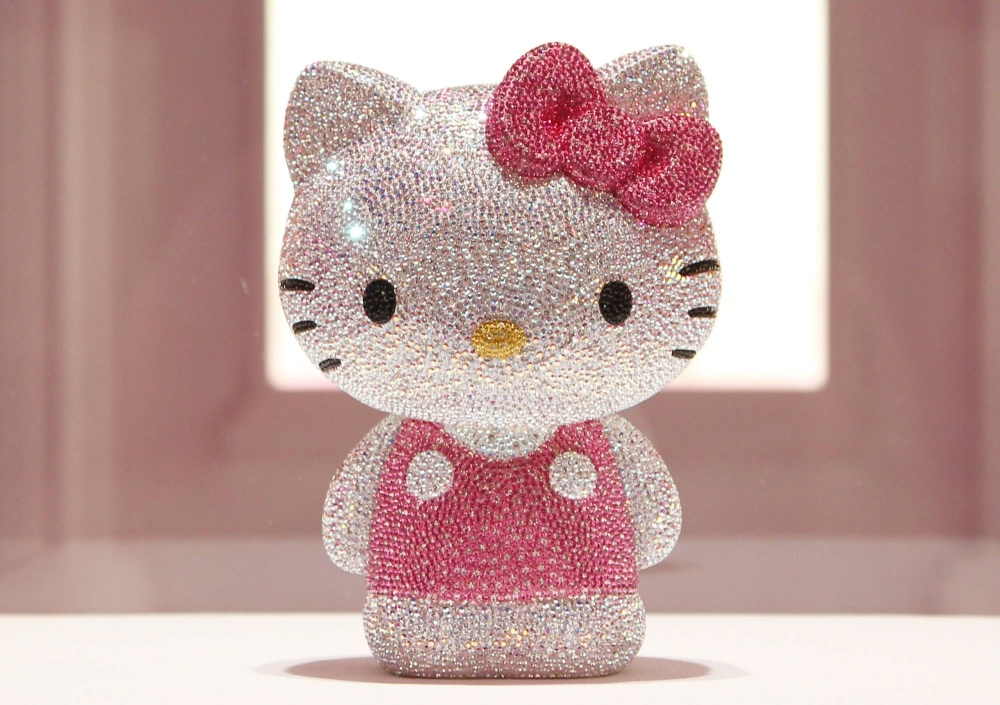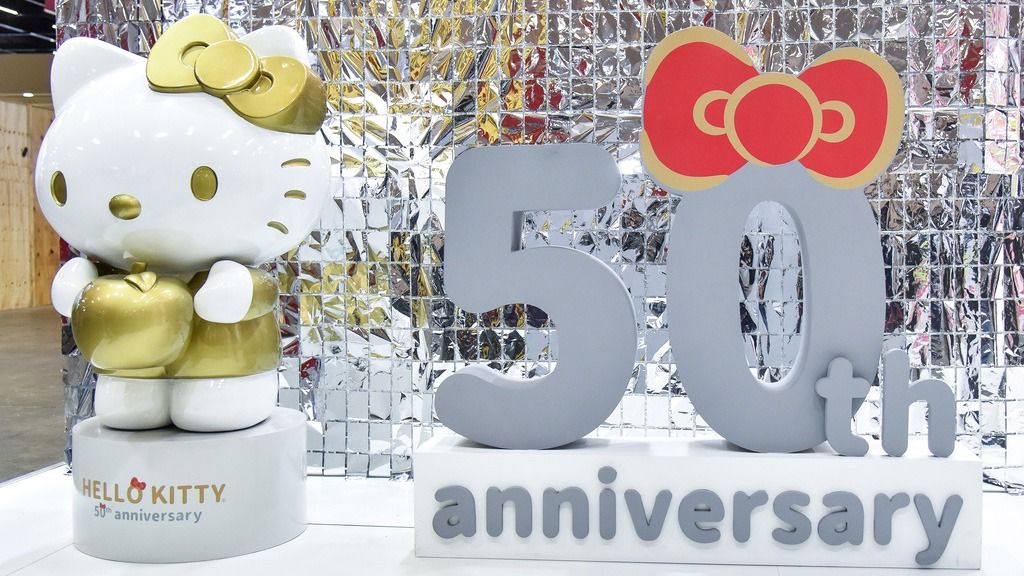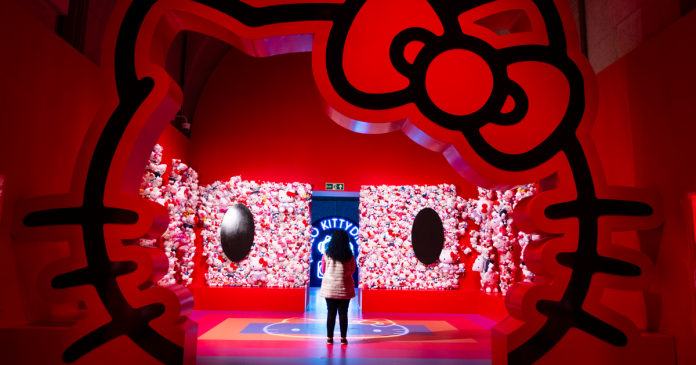Hello Kitty: Celebrating 50 Years of an Icon with a Heart and a Global Brand that Keeps Evolving.
Fifty years ago, a simple yet captivating character named Hello Kitty was born. Though widely known as a “cute cat,” Hello Kitty is much more—her story and persona have reached across continents, captivated multiple generations, and led her to become one of the most influential icons in Japanese pop culture. From stationery and toys to themed restaurants, clothing, and even luxury items, HelloKitty has left a lasting mark on the world, representing not only kawaii (cute) culture but also Sanrio’s vision of friendship, nostalgia, and lasting appeal.
As HelloKitty celebrates her 50th anniversary, let’s dive into her origins, global impact, and how her creator Sanrio has shaped her journey into a multi-billion-dollar franchise
HelloKitty, originally known as “Kitty White,” was created by Japanese company Sanrio in 1974 and introduced to the public in 1975. She was drawn by Yuko Shimizu, one of Sanrio’s early illustrators, as part of a line of characters intended to embody Japan‘s kawaii (cute) culture. Kitty White was designed with simplicity: a face without a mouth, an oval nose, and a signature red bow. These features have remained central to her appeal and her ability to be a “blank canvas” onto which fans can project their emotions.
HelloKitty’s official biography describes her as a cheerful girl living in London’s suburbs, which was a strategic decision by Sanrio to create an aura of exotic appeal for Japanese fans. Her very first product was a vinyl coin purse, and her popularity skyrocketed almost immediately. This propelled HelloKitty into a star within Sanrio’s roster of characters, and her image began to appear on all sorts of products, from toys and school supplies to lunchboxes and personal items.

HelloKitty’s journey took a significant turn in 1979 when Yuko Yamaguchi became her lead designer. With a keen sense of fashion and a deep connection to the brand’s fans, Yamaguchi understood that Hello Kitty had to evolve with her audience. She traveled to San Francisco in the early 1980s, absorbing Western trends in an era when HelloKitty was gaining traction outside Japan. Recognizing the American fascination with teddy bears, Yamaguchi introduced a friend for Hello Kitty—a teddy bear named Tiny Chum—and developed Hello Kitty’s family and friends.
Under Yamaguchi’s direction, Hello Kitty’s world expanded, as did her scenarios, which now included everything from sports to music. According to Yamaguchi, the character’s lack of a mouth allows fans to project their own emotions onto her, contributing to her timeless popularity.
Hello Kitty’s simple design and appeal to universal emotions helped her transcend cultural barriers, and she quickly gained fans worldwide. During Japan’s economic stagnation in the 1990s, Sanrio began focusing more on international markets. Initially marketed through door-to-door sales in the U.S., Hello Kitty became an instant hit when Sanrio opened its first retail outlet outside Japan, Gift Gate, in San Jose, California. Her popularity coincided with the rise of Japanese culture in the West, from anime to video games, further cementing her status as a cultural icon.
At the height of her popularity, HelloKitty was everywhere—books, video games, lunch boxes, fashion accessories, and even home appliances bore her image. Over the years, she has collaborated with several high-end brands, including Swarovski, Fender, and EVA Air, which even dedicated an airplane to her.
As a UNICEF ambassador and an envoy for Japan’s Foreign Ministry, Hello Kitty has not only been a commercial success but also a symbol of goodwill and cross-cultural friendship. Today, Hello Kitty stands among the most profitable media franchises globally, earning an estimated $80 billion, making her a close competitor to franchises like Pokémon and Star Wars.
As the generation that first grew up with Hello Kitty entered adulthood, Sanrio shifted its strategy to create Hello Kitty products that appealed to older audiences. In the late 1990s and early 2000s, Hello Kitty items began to appear in more sophisticated forms, like kitchenware and electronics. This shift was driven by the demand from fans who didn’t want to let go of their childhood mascot but desired products suited to adult life. A well-known Hello Kitty collector, Asako Kanda, embodies this nostalgic attachment, having amassed over 10,000 Hello Kitty items, turning her home into a tribute to her favorite character.
By continually evolving and catering to adults as well as children, Hello Kitty has achieved what few fictional characters can: remaining relevant across generations. Her fans from the 1980s and 90s are now passing their love for Hello Kitty to their own children, creating a cyclical surge in her popularity.

In 2020, Sanrio underwent a notable transformation under its new CEO, Tomokuni Tsuji, the grandson of Sanrio’s founder. At just 31 years old, Tsuji became the youngest CEO of a listed Japanese company and immediately set out to diversify Sanrio’s offerings, ensuring HelloKitty’s legacy could endure in a fast-changing world. Tsuji’s approach involved promoting newer Sanrio characters like Gudetama and Aggretsuko, which have both gained international acclaim and even found a home on platforms like Netflix.
According to Tsuji, the strategy isn’t about diminishing Hello Kitty’s popularity but rather about increasing the recognition of other Sanrio characters. This diversification has allowed Sanrio to expand its audience base and cater to various age groups. Aggretsuko, for example, resonates with Gen Z audiences as she reflects the challenges of modern adult life with humor and relatability, while Gudetama, the “lazy egg,” embodies a more unconventional take on cuteness, echoing the humorous side of self-care and low-energy living.
The staying power of HelloKitty has been reinforced through high-profile collaborations with brands like Starbucks, Crocs, and the Los Angeles Dodgers. These partnerships allow HelloKitty to remain ever-present in global markets, evolving to meet the latest consumer trends without losing her iconic appeal. In recent years, Sanrio has also employed artificial intelligence to combat counterfeit products, ensuring that the HelloKitty brand remains exclusive and valued by consumers.
Sanrio’s commitment to intellectual property protection has only further elevated Hello Kitty’s allure. By managing the character’s image and partnerships carefully, Hello Kitty continues to be one of the most recognized faces worldwide, especially in an age where nostalgia is a significant market driver.
Sanrio’s decision to make Hello Kitty a British schoolgirl rather than a Japanese cat has sparked curiosity and debate over the years. In a surprising 2014 revelation, a Sanrio executive shared that Hello Kitty is not, in fact, a cat but rather a British girl. This unexpected detail has intrigued fans, adding to her mystique. According to Tsuji, placing Hello Kitty in London may have been inspired by the appeal of British culture to Japanese girls at the time, though he is uncertain, as this decision predated his birth.
Hello Kitty’s versatility is further highlighted by her absence of a defined mouth, allowing fans to project their emotions onto her face. As Yamaguchi, her longtime designer, explained, “Hello Kitty is a blank canvas that you can transform into all sorts of things.”
As HelloKitty celebrates half a century, her future seems as bright as ever. Sanrio’s adaptability and willingness to evolve have ensured that HelloKitty remains beloved by fans of all ages. The company has weathered ups and downs in the market but has consistently found new ways to keep HelloKitty relevant. Analysts, including Yasuki Yoshioka of SMBC Nikko, have lauded Sanrio’s recent “V-shaped recovery” under Tsuji’s leadership.
With Hello Kitty as a cornerstone, Sanrio is poised to continue its cultural and financial success. As for Hello Kitty, she remains more than just a beloved figure; she’s a timeless symbol of friendship, nostalgia, and the universal language of cute.
In celebrating her 50th anniversary, Hello Kitty stands as a testament to the power of simplicity, adaptability, and cross-cultural appeal. Whether she’s a schoolgirl from London, a kawaii icon, or a global brand ambassador, Hello Kitty shows us that true icons don’t just adapt to trends—they transcend them.




